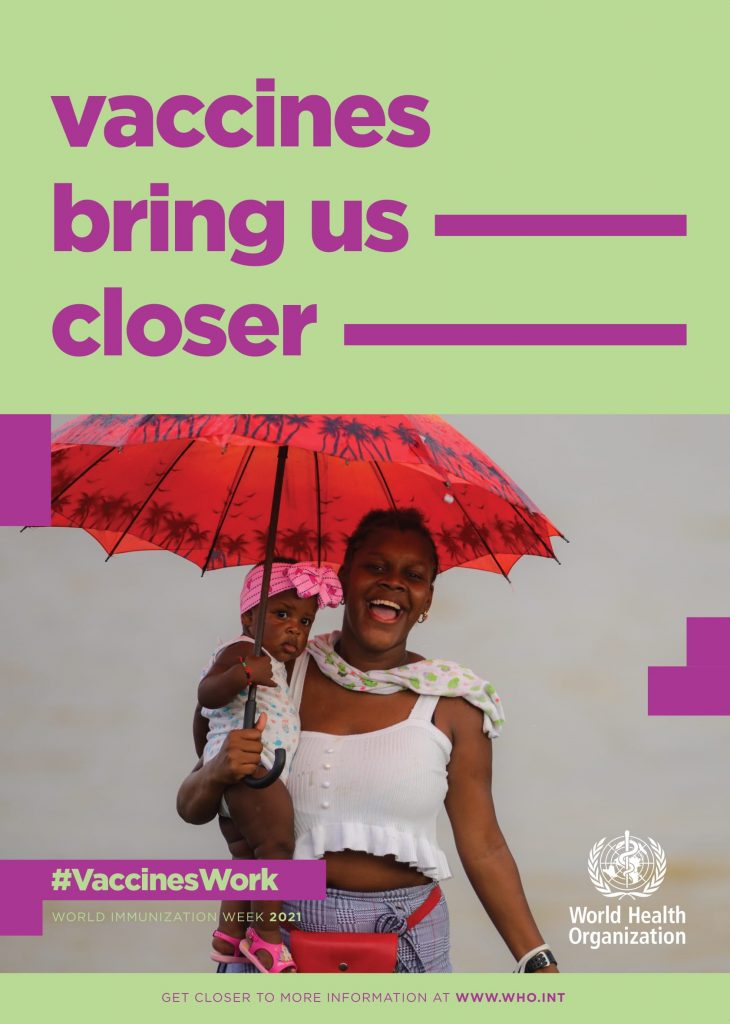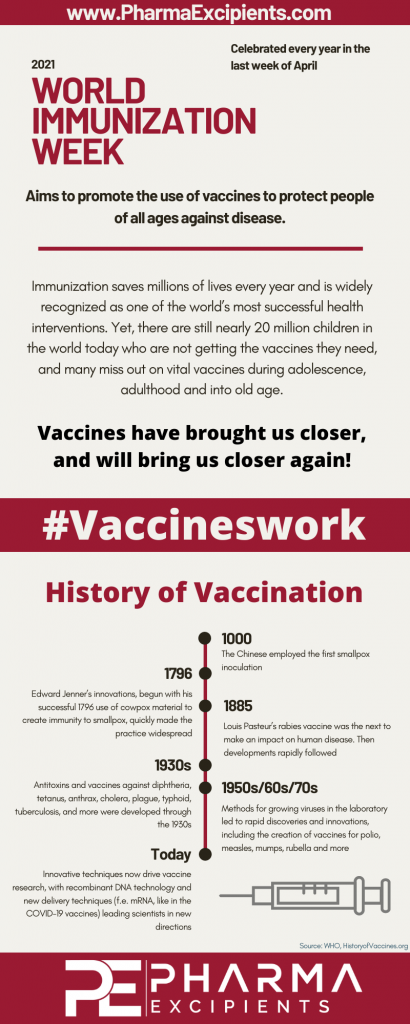World Immunization Week 2021

World Immunization Week – celebrated every year in the last week of April – aims to promote the use of vaccines to protect people of all ages against disease. Immunization saves millions of lives every year and is widely recognized as one of the world’s most successful health interventions. Yet, there are still nearly 20 million children in the world today who are not getting the vaccines they need, and many miss out on vital vaccines during adolescence, adulthood and into old age.
 Using the theme ‘Vaccines bring us closer’, World Immunization Week 2021 will urge greater engagement around immunization globally to promote the importance of vaccination in bringing people together, and improving the health and wellbeing of everyone, everywhere throughout life.
Using the theme ‘Vaccines bring us closer’, World Immunization Week 2021 will urge greater engagement around immunization globally to promote the importance of vaccination in bringing people together, and improving the health and wellbeing of everyone, everywhere throughout life.
As part of the 2021 campaign, WHO, partners and individuals around the world will unite to:
- Increase trust and confidence in vaccines to maintain or increase vaccine acceptance
- Increase investment in vaccines, including routine immunization, to remove barriers to access
While the world focuses on critically important new vaccines to protect against COVID-19, there remains a need to ensure routine vaccinations are not missed. Many children have not been vaccinated during the global pandemic, leaving them at risk of serious diseases like measles and polio. Rapidly circulating misinformation around the topic of vaccination adds to this threat.
In this context, this year’s campaign will aim to build solidarity and trust in vaccination as a public good that saves lives and protects health. To this end, we will be looking for more partners to join us, bringing people together in support of a lifesaving cause.
Vaccines have brought us closer, and will bring us closer again

For over 200 years, vaccines have protected us against diseases that threaten lives and prohibit our development. With their help, we can progress without the burden of diseases like smallpox and polio, which cost humanity hundreds of millions of lives
Whilst vaccines aren’t a silver bullet, they will again help us progress on a path to a world where we can be together again.
Vaccines themselves continue to advance, bringing us closer to a world free from the likes of TB and cervical cancer, and ending suffering from childhood diseases like tetanus and measles.
Investment and new research is enabling groundbreaking approaches to vaccine development, which are changing the science of immunization forever, bringing us closer still to a healthier future.
Source: WHO
More about the history of vaccination:
The story of vaccines did not begin with the first vaccine–Edward Jenner’s use of material from cowpox pustules to provide protection against smallpox. Rather, it begins with the long history of infectious disease in humans, and in particular, with early uses of smallpox material to provide immunity to that disease.
Evidence exists that the Chinese employed smallpox inoculation (or variolation, as such use of smallpox material was called) as early as 1000 CE. It was practiced in Africa and Turkey as well, before it spread to Europe and the Americas.
Edward Jenner’s innovations, begun with his successful 1796 use of cowpox material to create immunity to smallpox, quickly made the practice widespread. His method underwent medical and technological changes over the next 200 years, and eventually resulted in the eradication of smallpox.
Louis Pasteur’s 1885 rabies vaccine was the next to make an impact on human disease. And then, at the dawn of bacteriology, developments rapidly followed. Antitoxins and vaccines against diphtheria, tetanus, anthrax, cholera, plague, typhoid, tuberculosis, and more were developed through the 1930s.
The middle of the 20th century was an active time for vaccine research and development. Methods for growing viruses in the laboratory led to rapid discoveries and innovations, including the creation of vaccines for polio. Researchers targeted other common childhood diseases such as measles, mumps, and rubella, and vaccines for these diseases reduced the disease burden greatly.
Innovative techniques now drive vaccine research, with recombinant DNA technology and new delivery techniques leading scientists in new directions. Disease targets have expanded, and some vaccine research is beginning to focus on non-infectious conditions such as addiction and allergies.
Source: History of Vaccines
See also our article mRNA-lipid nanoparticle COVID-19 vaccines: Structure and stability



